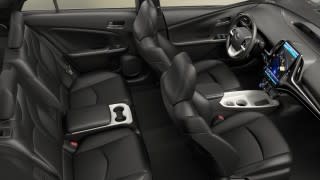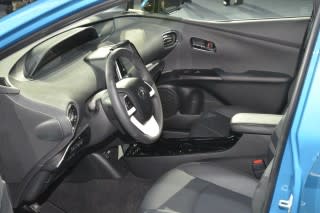2016 Toyota Prius Prime: details on 120 MPGe plug-in hybrid, all-electric mode
The 2017 Toyota Prius Prime replaces the Prius Plug-In, and it directly addresses nearly everything that current owners of that model have wanted.
There’s a longer, 22-mile electric driving range, better drivability, and exceptional 120+ MPGe fuel efficiency.
It even has one driving detail that will please plug-in enthusiasts right off the bat: The Prius Prime will, in its EV Mode, entirely lock in electric operation—even when you floor the accelerator.
DON'T MISS: 2017 Toyota Prius Prime plug-in hybrid: 22-mile range, styling updates: Live photos
At the New York Auto Show, we briefly caught up with Prius Prime chief engineer Koji Toyoshima to find out more about how the Prius Prime does this, what else differentiates the Prime from the rest, and where this technology might be headed.
In all-electric mode, the second generator motor is allowed to play the role of a supplemental traction motor.
A special one-way sprag clutch allows this differentiation between modes, letting it team up with the traction motor during EV-only operation, and restoring it to its normal Hybrid Synergy Drive role when the battery’s charge is exhausted.

“Visually, it would be hard to distinguish, but the transaxle has changed,” said Toyoshima, through a translator. Elaborating, the chief engineer noted that outside of that new motor and clutch, some components components of the planetary-gear torque-split arrangement have been reengineered and strengthened.
Much stronger 95-kW EV mode
In EV mode, there’s now a maximum of 95 kW (127 hp) from the electric motor system in EV operation, as compared to 68 kW in the Prius Plug-In.
That’s allowed Toyota to raise the maximum all-electric speed from 62 mph to 84 mph, say that performance is nearly as strong in electric mode, and quell concerns with the previous car that it wouldn’t have enough torque for safety if the gasoline engine were entirely kept out of the power flow.
ALSO SEE: Why Next Toyota Prius Plug-In Hybrid Is So Important: CA Laws
In the Prius Prime, the 8.8-kW lithium-ion battery pack is positioned just under and slightly aft of the back seat.
The seat configuration is slightly different; because of a thinner, somewhat repositioned seat, the Prime has a four-passenger layout; but the seat is 60/40-split and does fold forward—to a floor that’s not flat, but certainly useful for expanding weekend-shopping capacity.
The Prius Prime also features Toyota’s first carbon fiber rear hatch, which saves weight, while a dual-wave rear glass design helps cut drag.


 Yahoo Autos
Yahoo Autos 
